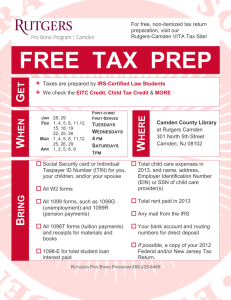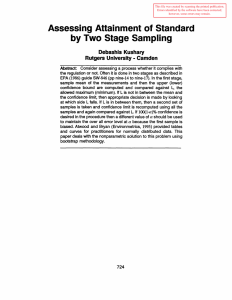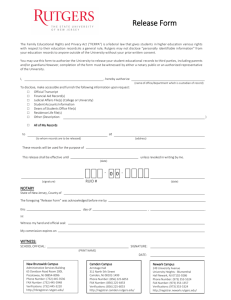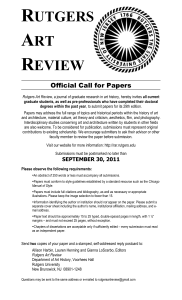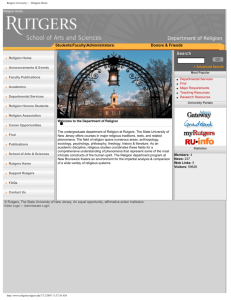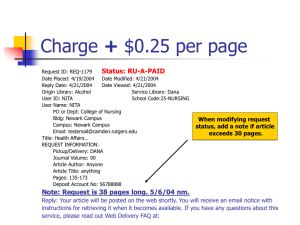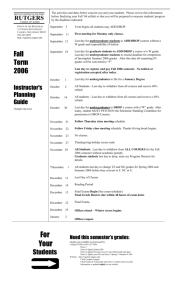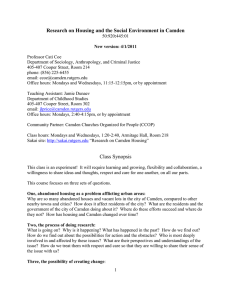CFA Syllabus - Rutgers University
advertisement
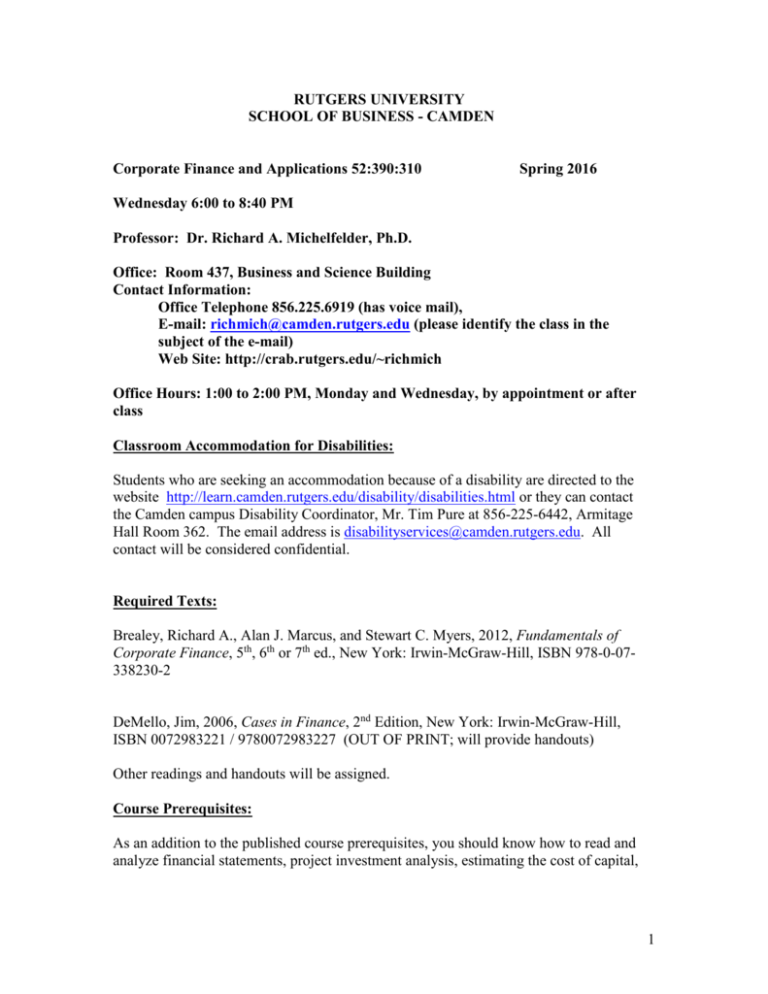
RUTGERS UNIVERSITY SCHOOL OF BUSINESS - CAMDEN Corporate Finance and Applications 52:390:310 Spring 2016 Wednesday 6:00 to 8:40 PM Professor: Dr. Richard A. Michelfelder, Ph.D. Office: Room 437, Business and Science Building Contact Information: Office Telephone 856.225.6919 (has voice mail), E-mail: richmich@camden.rutgers.edu (please identify the class in the subject of the e-mail) Web Site: http://crab.rutgers.edu/~richmich Office Hours: 1:00 to 2:00 PM, Monday and Wednesday, by appointment or after class Classroom Accommodation for Disabilities: Students who are seeking an accommodation because of a disability are directed to the website http://learn.camden.rutgers.edu/disability/disabilities.html or they can contact the Camden campus Disability Coordinator, Mr. Tim Pure at 856-225-6442, Armitage Hall Room 362. The email address is disabilityservices@camden.rutgers.edu. All contact will be considered confidential. Required Texts: Brealey, Richard A., Alan J. Marcus, and Stewart C. Myers, 2012, Fundamentals of Corporate Finance, 5th, 6th or 7th ed., New York: Irwin-McGraw-Hill, ISBN 978-0-07338230-2 DeMello, Jim, 2006, Cases in Finance, 2nd Edition, New York: Irwin-McGraw-Hill, ISBN 0072983221 / 9780072983227 (OUT OF PRINT; will provide handouts) Other readings and handouts will be assigned. Course Prerequisites: As an addition to the published course prerequisites, you should know how to read and analyze financial statements, project investment analysis, estimating the cost of capital, 1 capital structure analysis, dividend policy, risk estimation and analysis, to name a subset of topics. These topics will be covered in lectures. Course Objective: The objective of the course is to develop students’ skills in how to approach a business financial problem, perform the appropriate financial analysis, and make financial decisions. Becoming familiar with the application of finance involves practice, therefore the case study approach will be used in this course. In the practice of financial management, you are typically presented with problems or opportunities that need to be defined, framed, quantified, analyzed; leading to a multitude of potential alternative decisions, a final decision with consequential actions and results. Cases may not explicitly isolate an obvious framework for financial analysis and forthcoming decisionmaking. This is where your expertise as a financial analyst comes into play. Secondly, in most cases, you almost always do not have the benefit of full information. Information comes at a cost. You have to decide how much to collect, how much analysis to conduct, given the cost and reward associated with a bad or good decision. Making no decision is a decision to do nothing, which is usually but not always the worst decision that can be made. Decision-making involves taking a risk, committing to a course of action, and creating a result. Many business managers avoid making decisions due to the fear of making a bad decision that potentially result in losses, criticism, and “short-term” damage to careers. Note that the truly successful leaders, whether in business or other endeavors, are decisive, and therefore usually have a series of failures they can point to. We will make decisions in this class and not simply present the options and expected results, no matter what quantity or quality of information that we have. The cases we discuss in class will be a mixture of classes from the Case textbook and some cases developed by the professor, based on business experiences and observation. Academic Integrity “Academic integrity requires that all academic work be wholly the product of an identified individual or individuals. Joint efforts are only legitimate when the assistance of others is explicitly acknowledged…The principals of academic integrity entail simple standards of honesty and truth. Each member of the university has a responsibility to uphold the standards of the community and to take action when others violate them…Students are responsible for knowing what the standards are and for adhering to them. Students should also bring any violations of which they are aware to the attention of their instructors.”1 Students are expected to know, understand and adhere to the policies on academic integrity outlined above. Procedures for violation of these policies outlined in the 1 Rutgers University Code of Academic Conduct, taken from the Student Advising Handbook - http://camden-sbc.rutgers.edu/CurrentStudents/students/advising.pdf. 2 University Code of Academic Conduct will be followed. Classroom Protocol This protocol mimics standard expected behavior for business meetings. You are treated as professionals in my course. This comes with responsibilities. First, communication devices are not to be used in any way during class. Keep cell phone calls and texting use outside of the classroom. Two, it is expected that there will be no side-discussions during the lectures. Third, do not leave the classroom during class. You are scheduled to be in the room for one hour and twenty minutes without interruption. The class will start and stop promptly. Violations of this protocol will substantially affect your final grade through the participation portion of your grade. Overall Policy and Grading: Students will be divided into groups for the course and will make group case analyses, decisions, and presentations to the class. Everyone is expected to present before the end of the course. Students are expected to participate and contribute to their group analysis of case studies. Students are responsible for all text and other assigned readings in addition to all lecture material. Grades will be based on class participation, two examinations, and case analyses. Dates of examinations will be announced at least one week in advance. Mid-Term Examination: 20% This exam will involve a series of essays and mini-cases to be discussed. This is an individual effort. Final Examination: 30% This exam will be similar in nature to the mid-term examination but cover the entire course. This is an individual effort. Case Analyses: 40% Each group will receive a grade. The group will work together inside and outside of class to define, frame, analyze the case and report the case results in a memo (2-3 pages) and with a PowerPoint presentation to the class. Due to the large number of cases and groups, presentation of cases will be selected randomly with all groups doing an equal number of presentations. However, all groups must submit a memo and PowerPoint presentation even if they are not selected to present. Timing and frequency of presentations are based on the number of students enrolled. Also, an assignment involving the use of the Bloomberg data system will be distributed. Please participate in one of the training sessions on the use of the Bloomberg system for this course and for your career. 3 Class Participation: 10% This will involve two components, one developed by the professor based on class discussions, class behavior, attendance and another assigned to each member of a group by the group that is based on their contribution to the group. The professor reserves the right to reject group grades if assigned grades seem inflated. This will be based on the sole discretion of the professor. Participation involves attendance, class discussion, paying attention, appropriate behavior and following classroom protocol as discussed above. COURSE OUTLINE TOPICS TEXT 1. Introduction to Financial Statements 2. Business Financial Planning and Forecasting Risk, Return, and Cost of Capital Chapters 3, 4 (3, 17) 18 3. 4. 5. 6. 7. 8. Project Investment DecisionMaking MID-TERM EXAMINATION Stock and Bond Valuation Capital Structure Dividend Policy Mergers / Acquisitions 11, 12, 13 (10, 11, 12 8, 9, 10 (7, 8, 9) 6, 7 (5,6) 16 (15) 17 (16) 21 (21) CASE CASE No. 2. Bigger Isn’t Always Better 3.1 Flirting with Risk 3.2 It’s Better Late Than Never 3.3 We Are Not All Alike 4.1 The Lazy Mower: Is It Really Worth It? 4.2 Our Napa Valley Bed & Breakfast “Dream” 2 5.1 Corporate Bonds – They Are More Complex Than You Think 5.2 How Low Can It Go? 5.3 Lets Buy A Restaurant 6.1 Look Before You Leverage 6.2 Becoming A Camden Landlord 7.1 Is It Much Ado About Nothing 7.2 Electric Utilities’ Problems With Dividend Cuts 8.1 Made For Each Other 8.2 Lets Recommend An Energy Company Merger 10 17 7 20 13 Handout 11 Handout 24 Handout 26 Handout 33 Handout Notes: 4 1. Other cases and “mini-cases” may be included in the course as deemed appropriate by the professor. 2. Chapters in ( ) refer to the 5th edition of Brealey, et. al. text. 5
